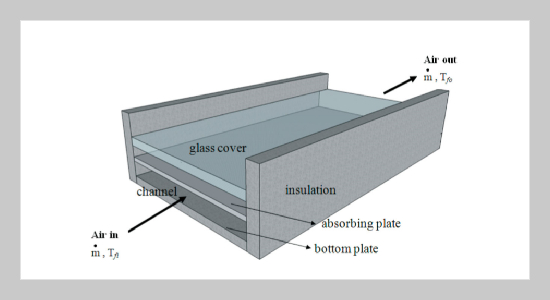REFERENCES
- [1] Garg, H. P. and Adhikari, R. S., “Performance Evaluation of a Single Solar Air Heater with n-Subcollectors Connected in Different Combinations,” International Journal of Energy Research, Vol. 23, pp. 403�414 (1999). doi: 10.1002/(SICI)1099-114X(199904)23:5 3.0.CO;2-F
- [2] Belusko, M., Saman, W. and Bruno, F., “Performance of Jet Impingement in Unglazed Air Collectors,” Solar Energy, Vol. 82, pp. 389�398 (2008). doi: 10.1016/j. solener.2007.10.005
- [3] Duffie, J. A. and Beckman, W. A., Solar Engineering of Thermal Processes, Wiley, New York (1991).
- [4] Koyuncu, T., “Performance of Various Design of Solar Air Heaters for Crop Drying Applications,” Renewable Energy, Vol. 31, pp. 1073�1088 (2006). doi: 10. 1016/j.renene.2005.05.017
- [5] Liu, C. H. and Sparrow, E. M., “Convective-Radiative Interaction a Parallel Plate Channelapplication to AirOperated Solar Collectors,” International Journal of Heat and Mass Transfer, Vol. 23, pp. 1137�1146 (1980). doi: 10.1016/0017-9310(80)90178-7
- [6] Yeh, H. M. and Ting, Y. C., “Effects of Free Convection on Collector Efficiencies of Solar Air Heaters,” Applied Energy, Vol. 22, No. 2, pp. 145�155 (1986). doi: doi:10.1016/0306-2619(86)90078-4
- [7] Forson, F. K., Nazha, M. A. A. and Rajakaruna, H., “Experimental and Simulation Studies on a Single Pass, Double Duct Solar Air Heater,” Energy Conversion and Management, Vol. 44, pp. 1209�1227 (2003). doi: 10.1016/S0196-8904(02)00139-5
- [8] Naphon, P., “On the Performance and Entropy Generation of the Double-Pass Solar Air Heater with Longitudinal Fins,” Renewable Energy, Vol. 30, pp. 1345� 1357 (2005). doi: 10.1016/j.renene.2004.10.014
- [9] Yeh, H. M., Ho, C. D. and Lin, C. Y., “Effect of Collector Aspect Ratio on the Collector Efficiency of Upward Type Baffled Solar Air Heaters,” Energy Conversation and Management, Vol. 41, No. 9, pp. 971� 981 (2000). doi: 10.1016/S0196-8904(99)00148-X
- [10] Goldstein, L. and Sparrow, E. M., “Experiments on Transfer Characteristics of a Corrugated Fin and Tube Heat-Exchanger Configuration,” ASME Journal of Heat Transfer, Vol. 98, pp. 26�34 (1976). doi: 10. 1115/1.3450464
- [11] Gao, W. F., Lin, W. X. and Lu, E. R., “Numerical Study on Natural Convection Inside the Channel between the Flat-Plate Cover and Sine-Wave Absorber of a CrossCorrugated Solar Air-Heater,” Energy Conversation Management, Vol. 41, pp. 145�151 (2000). doi: 10. 1016/S0196-8904(99)00098-9
- [12] Gao, W., Lin, W., Liu, T. and Xia, C., “Analytical and Experimental Studies on the Thermal Performance of Cross-Corrugated and Flat-Plate Solar Air Heaters,” Applied Energy, Vol. 84, pp. 425�441 (2007). doi: 10.1016/j.apenergy.2006.02.005
- [13] Chaube, A., Sahoo, P. K. and Solanki, S. C., “Analysis of Heat Transfer Augmentation and Flow Characteristics Due to Rib Roughness over Absorber,” Renewable Energy, Vol. 31, pp. 317�331 (2006). doi: 10.1016/ j.renene.2005.01.012
- [14] Kays, W. M. and Crawford, M. E., Convective Heatand-Mass Transfer, McGraw-Hill, New York (1980). doi: 10.1016/0017-9310(67)90130-5
- [15] McAdams, W. H., Heat Transmission, Third ed., McGraw-Hill, New York (1954). doi: 10.1126/science. 120.3128.984
- [16] Klein, S. A., “Calculation of Flat-Plate Loss Coefficients,” Solar Energy, Vol. 17, No. 1, pp. 79�80 (1975). doi: 10.1016/0038-092X(75)90020-1
- [17] Hottel, H. C. and Woertz, B. B., “Performance of Flat-Plate Solar-Heat Collector,” Transactions of the ASME, Vol. 64, pp. 91�104 (1942).
















